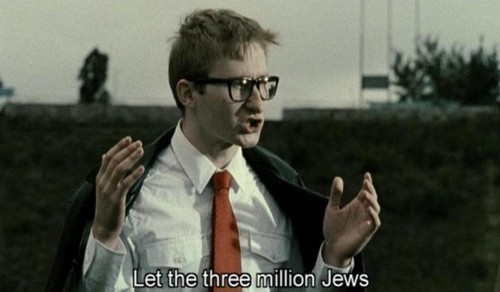Yael Bartana
27 Mar - 22 May 2010
YAEL BARTANA
"If You Want, We'll Travel to the Moon Together"
27.3 - 22.5
Yael Bartana's work deals mainly with Israeli society as seen through significant events in Jewish history throughout the twentieth century. It explores the role of manifestations of the State, such as propaganda films, archival materials, the military, symbols, rituals, uniforms and national anthems, as visual markers of contemporary Israeli society.
A new video installation features two films from Bartana's (unfinished) Polish trilogy: Mary Koszmary (Nightmares), 2007, and Mur I Wieza (Wall and Tower), 2009, showing for the first time in Israel.
In Mary Koszmary, journalist and leftist activist Slawomir Sierakowski is seen speaking to an empty, abandoned stadium. He is calling for the return of three million Polish Jews to their homeland:
"Today we are fed up looking at our similar faces. On the streets of our great cities, we are on the lookout for strangers and listening intently when they speak. Yes! Today we know that we cannot live alone. We need the other, and there’s no closer other for us than you! Return!"
The reaction to Sierakowski’s call is realized in the second part of the trilogy, Mur I Weiza. In the former Warsaw Ghetto, facing the Monument to the Heroes of the Warsaw Ghetto the first “Wall and Tower” kibbutz in Europe is being built. In this political hallucination, pioneers from The Jewish Renaissance Movement in Poland (JRMiP) are returning to Polish soil, Using the tactic employed by Jewish pioneers in Palestine during the British Mandate and The Arab Revolt (1936-1939),they hastily build a structure as the basis for their settlement.
The logo of The Jewish Renaissance Movement is consists of a hawk and a Star of David, a hybrid that embodies both a traumatic history and the Zionist dream. Bartana touches on themes of nationalism and military power, evoking memories of anti-Semitism and extermination that have accompanied the Zionist settlement in Israel.
Yael Bartana was born in 1970 in Kfar Yehezkel. Her work has been shown in solo and group exhibitions in Israel and abroad. Selected solo exhibitions: Moderna Museet, Malmo; Museum of Modern Art, Warsaw (2010); P.S.1 MOMA, NY (2009); Foksal Gallery, Warsaw; Center for Contemporary Art, Tel-Aviv (2008); "MARCH," Fondazione per l'arte Contemporanea (2007); The Power Plant, Toronto (2007); Kunstverein Hamburg, Hamburg; Stedelijk van Abbemuseum, Eindhoven (2006); Selected group exhibitions: Artes Mudis, Wales; "The Early Years," KW, Berlin (2010); "Architecture and Memory," British Film Institute, London; "H-Box," Tate Modern, London; Centre Pompidou, Paris; Documenta 12, Kassel; San-Francisco Art Institute; Herzliya Museum of contemporary Art, and many more.
Bartana is the recipient of the Anselm Kiefer Prize, The Wolf Foundation, IL (2003); Doothea von Stetten Kunstpreis, Bonn (2005); Ministry of Science, Sport and Education prize (2006); Gottesdiener Foundation for Israeli Art (2007). She is shortlisted for the Artes Mundi prize, 2010.
"If You Want, We'll Travel to the Moon Together"
27.3 - 22.5
Yael Bartana's work deals mainly with Israeli society as seen through significant events in Jewish history throughout the twentieth century. It explores the role of manifestations of the State, such as propaganda films, archival materials, the military, symbols, rituals, uniforms and national anthems, as visual markers of contemporary Israeli society.
A new video installation features two films from Bartana's (unfinished) Polish trilogy: Mary Koszmary (Nightmares), 2007, and Mur I Wieza (Wall and Tower), 2009, showing for the first time in Israel.
In Mary Koszmary, journalist and leftist activist Slawomir Sierakowski is seen speaking to an empty, abandoned stadium. He is calling for the return of three million Polish Jews to their homeland:
"Today we are fed up looking at our similar faces. On the streets of our great cities, we are on the lookout for strangers and listening intently when they speak. Yes! Today we know that we cannot live alone. We need the other, and there’s no closer other for us than you! Return!"
The reaction to Sierakowski’s call is realized in the second part of the trilogy, Mur I Weiza. In the former Warsaw Ghetto, facing the Monument to the Heroes of the Warsaw Ghetto the first “Wall and Tower” kibbutz in Europe is being built. In this political hallucination, pioneers from The Jewish Renaissance Movement in Poland (JRMiP) are returning to Polish soil, Using the tactic employed by Jewish pioneers in Palestine during the British Mandate and The Arab Revolt (1936-1939),they hastily build a structure as the basis for their settlement.
The logo of The Jewish Renaissance Movement is consists of a hawk and a Star of David, a hybrid that embodies both a traumatic history and the Zionist dream. Bartana touches on themes of nationalism and military power, evoking memories of anti-Semitism and extermination that have accompanied the Zionist settlement in Israel.
Yael Bartana was born in 1970 in Kfar Yehezkel. Her work has been shown in solo and group exhibitions in Israel and abroad. Selected solo exhibitions: Moderna Museet, Malmo; Museum of Modern Art, Warsaw (2010); P.S.1 MOMA, NY (2009); Foksal Gallery, Warsaw; Center for Contemporary Art, Tel-Aviv (2008); "MARCH," Fondazione per l'arte Contemporanea (2007); The Power Plant, Toronto (2007); Kunstverein Hamburg, Hamburg; Stedelijk van Abbemuseum, Eindhoven (2006); Selected group exhibitions: Artes Mudis, Wales; "The Early Years," KW, Berlin (2010); "Architecture and Memory," British Film Institute, London; "H-Box," Tate Modern, London; Centre Pompidou, Paris; Documenta 12, Kassel; San-Francisco Art Institute; Herzliya Museum of contemporary Art, and many more.
Bartana is the recipient of the Anselm Kiefer Prize, The Wolf Foundation, IL (2003); Doothea von Stetten Kunstpreis, Bonn (2005); Ministry of Science, Sport and Education prize (2006); Gottesdiener Foundation for Israeli Art (2007). She is shortlisted for the Artes Mundi prize, 2010.

